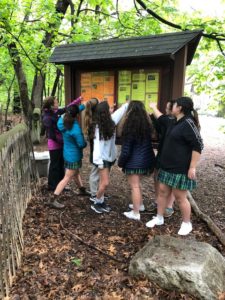
Spring arrived suddenly this May, its beauty offsetting the explosion of invasive plants needing immediate attention. Science teachers searching for a way to keep restless students engaged at the end of a long year connected with Blackstone Parks Conservancy (BPC) volunteers to work outdoors and learn while contributing to the community.
Lincoln School Volunteers
Visiting Blackstone Park several times, younger Lincoln School volunteers went for walks and collected trash. High-school students with science teacher Ann Lovely created a display on invasive plants for the kiosk and put their research to practice by removing invasive mugwort and garlic mustard. Yet another group spent their annual service day removing invasive Norway maples with guidance from City Forester Doug Still.
Wheeler Students Take on the Godzilla of Invasive Plant Species
As part of the citywide Founders Day celebration, 35 Wheeler students in the 6th, 9th, and 10thgrades took on a thick standing army of Japanese knotweed in the ravine behind York Pond this year. While the small cadre of BPC park committee volunteers had tackled smaller infestations of the ravenous invasive species, this gigantic stand had long stumped them. Given the extent of roots underground, and the difficulty of removing them, the knotweed in the ravine has been the place to get to “some day.”
Of the dozen or so species of invasive plants that encroach on the 45-acre Blackstone Park Conservation District, knotweed, with bamboo-like stalks that can grow eight inches a day in spring, inspires the most awe. Roots shoot down as far as nine feet and radiate out twenty, meeting in rhizomes sometimes as large as small boulders. Broken pieces quickly regenerate.
Remarkably, the students and their teachers, armed with shovels and guided by URI-trained Conservancy team leaders Carrie Drake and Rick Richards, won the first round. They pulled and dug up the close-growing stalks in an area roughly 100 by 30 feet. Then, like beaters in a hunting party, they spread out in a long line and advanced with determined faces, gathering stalks and rhizomes and throwing them onto an enormous pile.
Afterwards, the students spread black plastic on the cleared land in order to deny the remaining knotweed pieces sun and water. It will take about six years of repeating this process to control knotweed in the ravine.
Jane Peterson


 Kirsten A. Bagaglia, CRPC
Kirsten A. Bagaglia, CRPC